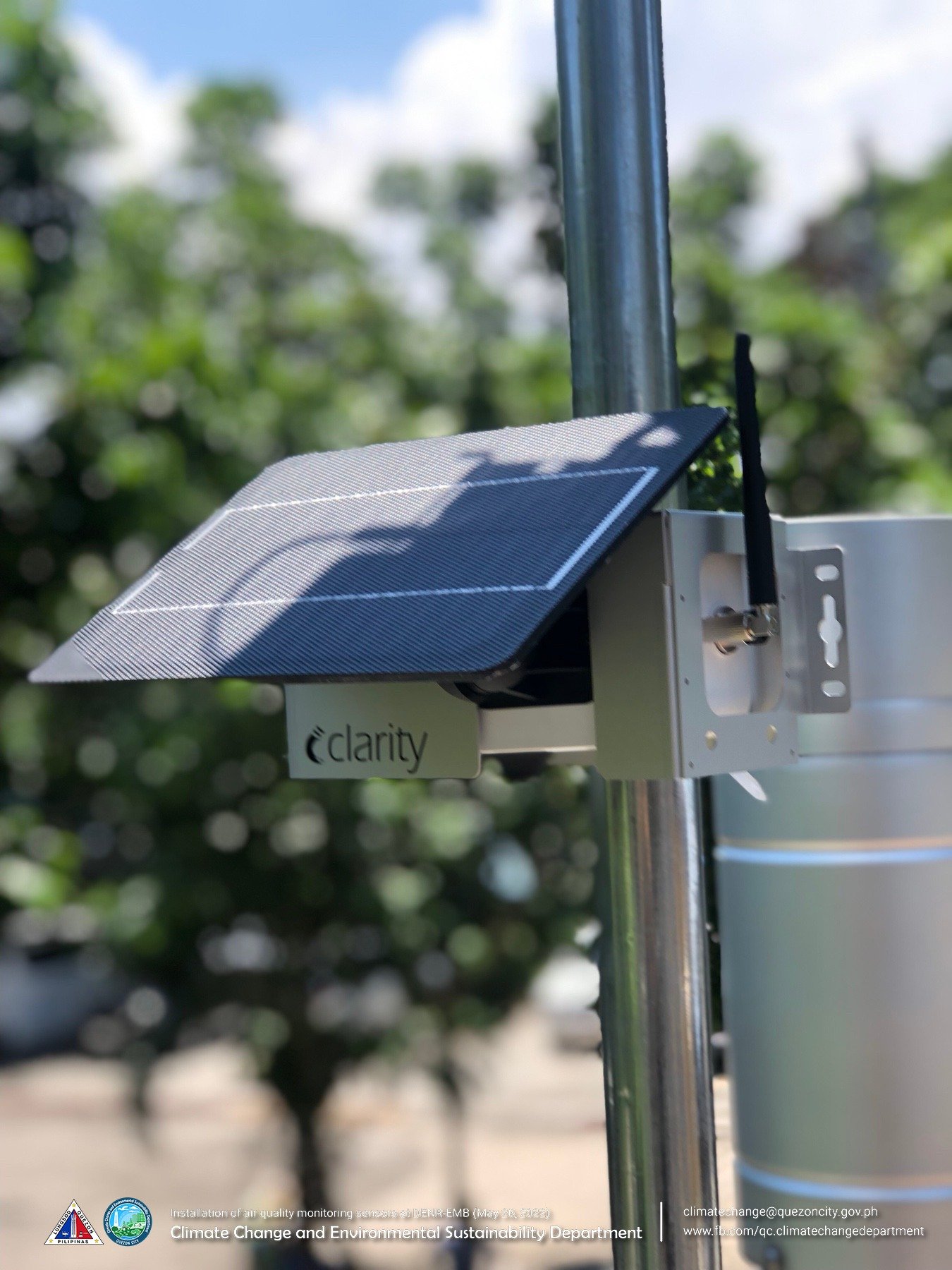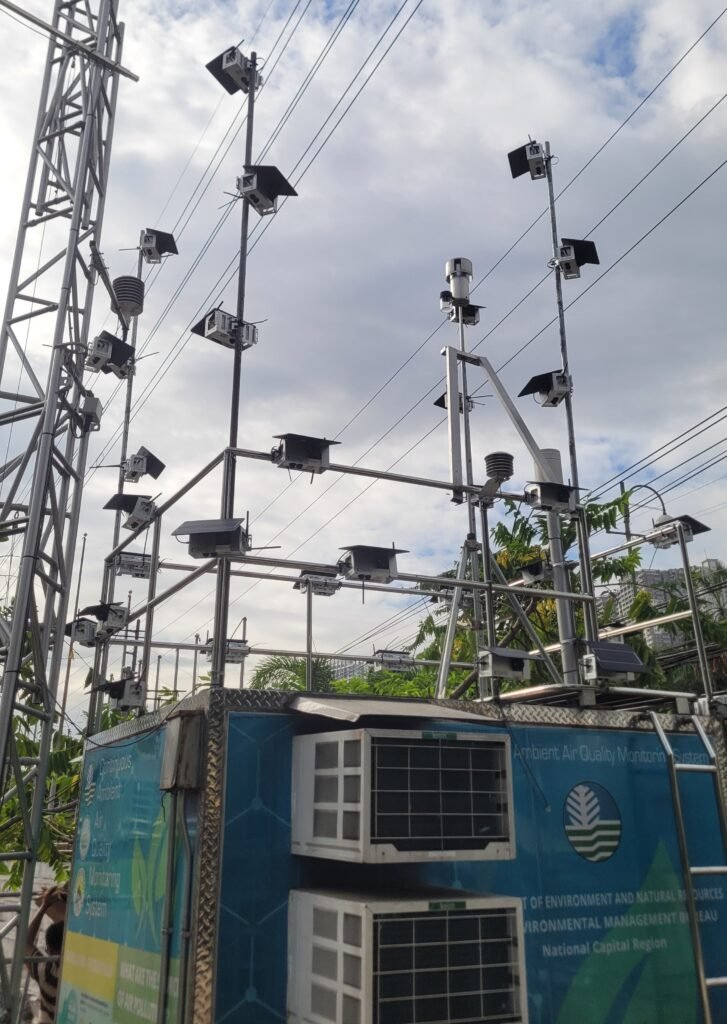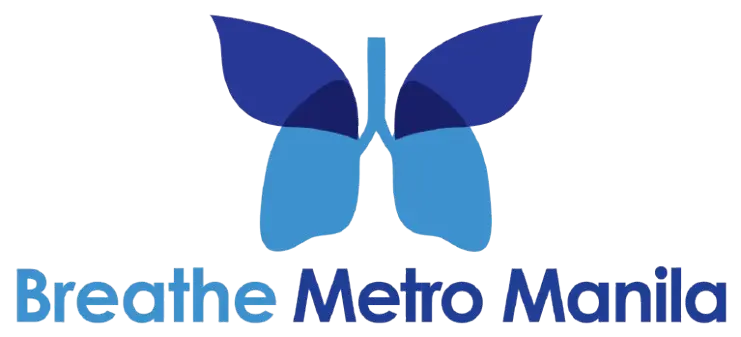Monitoring Network
Manila Air Quality Map & Monitoring Network
Explore our interactive Breathe Metro Manila air quality map to see real-time data from across the Metro Manila region. Our extensive network of sensors provides up-to-date information, helping you make informed decisions about your health and activities based on air quality in your area.
About Our Air Quality Monitoring Network
Breathe Metro Manila consists of a hybrid network of reference-grade air quality analyzers owned by DENR-EMB alongside air quality sensors. Sensors are not as accurate as reference monitors but can be used to identify and characterize air pollution at high spatial and temporal resolution.
Breathe Metro Manila has teamed up with Clarity Movement Co., a distinguished sensor company headquartered in California that engineered the Node-S, a lightweight and compact sensor designed to measure PM₂.₅ particulate matter and nitrogen dioxide (NO₂). The Node-S pictured to the right is from Quezon City’s network of 40 Clarity Nodes, which was deployed in 2022 and forms part of the core Breathe Metrol Manila air quality monitoring network.

Solar-Powered Node-S
The Node-S can operate using solar power, making it suitable for deployment across large urban areas like Metro Manila. This advanced device has been successfully deployed in more than 70 countries globally, and has undergone rigorous evaluations by the South Coast Air Quality Management District in California and Airparif in Paris, ensuring its reliability and accuracy in air quality measurement.

Ensuring Data Accuracy and Reliability
At Breathe Metro Manila, we prioritize the accuracy and reliability of our air quality data — which is why all Breathe Metro Manila Nodes are co-located with DENR-EMB NCR reference monitors before being deployed . By co-locating our sensors alongside reference monitors (pictured), we can rigorously assess their performance.
This process enables us to derive a device-specific correction factor that is carefully adjusted to reflect local conditions at each co-location site. Once deployed, Clarity’s team of air quality experts evaluates the performance of the sensors against specific statistical targets, ensuring their long-term accuracy and effectiveness in monitoring air quality.
Who runs the Breathe Metro Manila network?
Ateneo Business Insights Laboratory for Development (BUILD)
Ateneo de Manila University, through the John Gokongwei School of Management (JGSOM), officially launched the Business Insights Laboratory for Development (BUILD) on 23 May 2024. Through expertise from Ateneo faculty and students, BUILD aims to advance the use of operations research, data analytics, financial modeling, generative artificial intelligence, and data platform services to enhance the economic competitiveness of small and medium enterprises in the Philippines.
Ateneo BUILD
Leveraging the expertise held across the entire university, BUILD is uniquely positioned to provide external stakeholders with the rigor needed in research for data-driven decision-making and to provide expertise across several domains outside of business, such as psychology, education, health, economics, computer science, and education. The experiences from engagements with the industry partners shall be used to fulfill Ateneo's mission in education, particularly research, curriculum development, faculty development, and student enterprise empowerment.
BUILD will initiate innovation through academic research on topics of interest to students and faculty or influenced by industry interactions. The center will centralize research output in a repository named the Ateneo Integrated Open Library (AOLI). These resources will form the foundation for various initiatives, including internal and public workshops, toolkits for consultancies and managed services, and potential spin-outs.
Manila Observatory
The Manila Observatory is a research institution that does science to empower communities to take up the urgent challenges of sustainable development and disaster risk resilience. Established in 1865 under the auspices of the Jesuit mission in the Philippines, the Observatory was the official meteorological and seismological agency of the Philippines until operations were handed over to the Philippine government in the aftermath of World War II. Since then, as a non-profit institution, it has been bringing science to bear on various environmental concerns.
These days, the Observatory has been deploying the atmospheric and earth sciences, remote sensing technologies, the instrumentation and data sciences to help communities to respond to the climate emergency.
Knowing science to be essential but not enough, the Observatory has collaboratories working in climate policy and practice that connect the scientific work of its laboratories to the needs of society.
Air Quality Dynamics
The Air Quality Dynamics (AQD) program aims to provide scientific guidance to air quality assessment and mitigation policy development. It seeks to achieve this through monitoring and modeling activities that form the scientific basis of effective air quality management.
The monitoring branch of this program utilizes gas and aerosol sampling technologies to diagnose the present state of urban air quality. The diagnosis is complemented with observations of the urban atmospheric circulation through meteorological monitoring systems.
The modeling branch of the program applies source apportionment, dispersion, and mesoscale modeling systems to deepen our understanding of the sources, transport, and fate of critically important air pollutants in Asian urban centers such as Manila.
ASMPH Center for Research and Innovation (ACRI)
The ASMPH Center for Research and Innovation is the research unit of the Ateneo School of Medicine and Public Health. It is a growing team of researchers across various subjects of interests, including health systems, mental health, neuro-developmental disorders, environmental health, medical equipment, and digital health, among others.
It has strived to develop research outputs that can impact not only the learning community within the university, but most especially practitioners, policymakers, and community members in the Philippines and across the globe.
How is the network funded?
The initial funding for the deployment of Breathe Metro Manila's sensor network was generously provided by the Department of Environment and Natural Resources - Environmental Management Bureau National Capital Region (DENR-EMB NCR) and the Quezon City government. This collaboration was facilitated by C40 Cities, a network dedicated to addressing climate change. The funding supported the initial batch of sensors, enabling us to establish a robust foundation for air quality monitoring throughout the city.
In addition to government support, we seek partnerships and sponsorships to expand and maintain our network. These collaborations focus on placing sensors in critical locations such as schools and hospitals and enhancing community engagement through targeted monitoring and educational initiatives.
Through advanced air quality monitoring technologies and community engagement, we strive to create impactful changes in air quality policies and public health awareness. Our real-time air quality data helps identify pollution hotspots and tracks air quality trends. This data supports our mission to advocate for cleaner air through science-based policies and practices.

